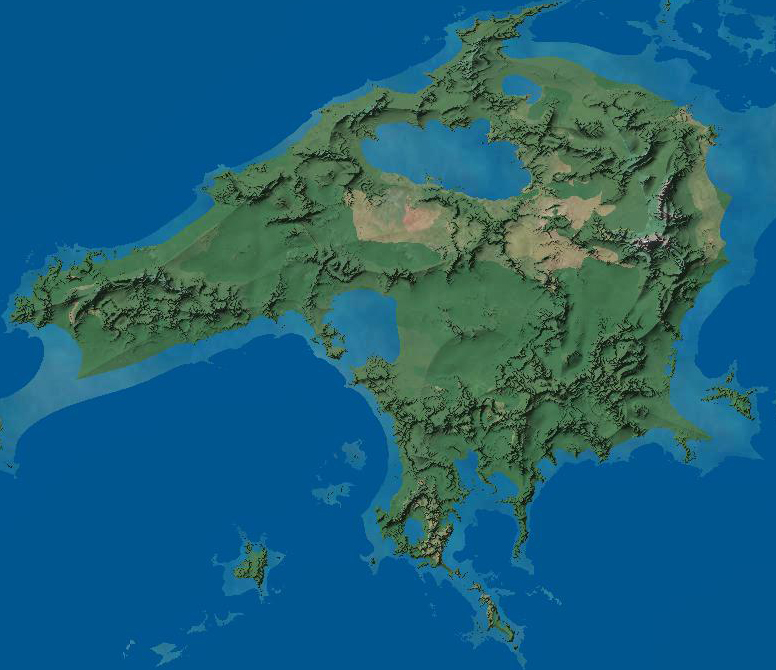FT: Remove "Seams" in Wilbur Ridged Multfractal Map?
Been a long time since I've played with the PF tools; dipping my toes back in with the world map for my Shaper's World storyworld, which was created years ago in Wilbur and then re-created in Fractal Terrains.
The map, generated with the Wilbur Ridged Multifractal setting, has always had an issue with "seams" running through it -- they appear to be mathematical artifacts that are visible at every zoom level. See attached image for the continent-wide example. The "seam" seems to be about .10 feet higher than the surrounding terrain regardless of location on the map, based on the cursor position / view properties info, but don't hold me to that -- seems imprecise(?).
Anyway, maybe I'm being unnecessarily precious, but I'd love to know how to undo / eliminate these artifacts without significantly altering the appearance / topography of the world. I love my girl, and I don't want cosmetic surgery to ruin her, if you follow.
Thoughts? Thanks!
The map, generated with the Wilbur Ridged Multifractal setting, has always had an issue with "seams" running through it -- they appear to be mathematical artifacts that are visible at every zoom level. See attached image for the continent-wide example. The "seam" seems to be about .10 feet higher than the surrounding terrain regardless of location on the map, based on the cursor position / view properties info, but don't hold me to that -- seems imprecise(?).
Anyway, maybe I'm being unnecessarily precious, but I'd love to know how to undo / eliminate these artifacts without significantly altering the appearance / topography of the world. I love my girl, and I don't want cosmetic surgery to ruin her, if you follow.
Thoughts? Thanks!



Comments
How did you create the topography? Was it in Wilbur?
See my original post: "the world map for my Shaper's World storyworld, which was created years ago in Wilbur and then re-created in Fractal Terrains"
I can't say for sure, but it should be possible to hand edit out most of the ridges in the open ground using FT3s editing tools because the underlying fractal in the FT3 file will be different to the fractal used to create the world in Wilbur - if yo use what I mean. Since there won't be a ridge there in the underlying FT3 fractal (except by some humungous stroke of bad luck) it shouldn't be too difficult to carefully blend it with the surrounding land.
I'm not entirely sure which tools to suggest, though so it would probably be better to wait and hear what some of the more learned experts have to say on the matter. Unfortunately I have no idea if they are all at GenCon, or if one of them might be along a bit later and be kind enough to make a few more precise suggestions.
I tried selecting a small section of one seam, but I'm not sure which tool to use to make a nice subtle smoothing with the result that the seam matches the elevation surrounding it. My by-hand efforts looked awful...
But maybe someone can still help, so don't give up
One thing that you could do would be increase the editing resolution of the map using Map>>World Settings with a custom editing value of about 8000 and then use Tools>>Actions>>Burn In To Surface to convert the fractal function into offset-channel editing data. Then you could use any editing tools like blurring to adjust the sharp edges. Unfortunately, this technique sharply limits the available resolution of the world.
Another option might be to paint in lower land roughness across the objectionable ridgelines. They will still be there, but should be less prominent. The painting tools in FT3 can be a bit fiddly, though.
I've got the Octaves setting at "8." What do you mean by successive octaves?
Tried playing with lowering land roughness; it's so imprecise... minor differences, and then POW, a row of lakes...
What lower roughness is doing is scaling the world down closer and closer to 0. Close enough to 0 and things suddenly appear as ocean. Another option might be to just paint a roughness value of 0.1 into the location, but that's even harder to control (when painting with a value instead of raise/lower, you'll probably do better to click areas with a wide brush rather than clicking and dragging with a smaller one).